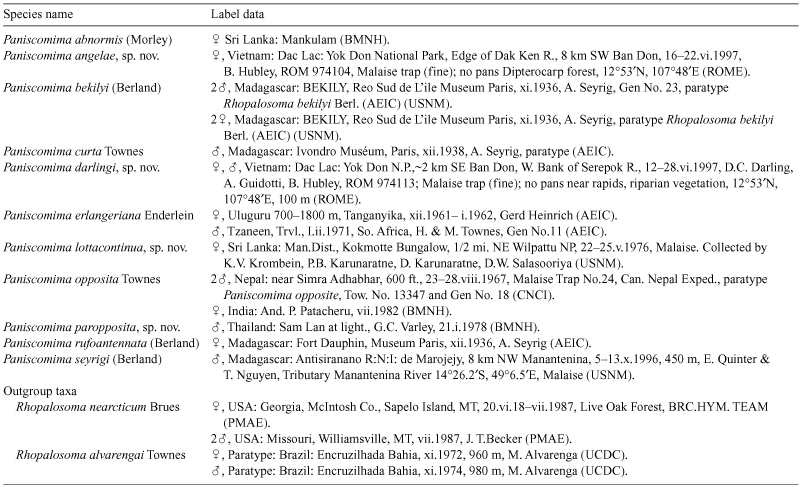A revision of the wasp genus Paniscomima (Hymenoptera : Rhopalosomatidae) and a proposal of phylogenetic relationships among species
Antonia Elena GuidottiDepartment of Natural History, Royal Ontario Museum, 100 Queen’s Park, Toronto, Ontario M5S 2C6, Canada. Email: antoniag@rom.on.ca
Invertebrate Systematics 21(4) 297-309 https://doi.org/10.1071/IS04027
Submitted: 28 September 2004 Accepted: 27 June 2007 Published: 20 September 2007
Abstract
Species of the wasp family Rhopalosomatidae are parasitoids of crickets. The last revision of this family was completed 30 years ago. Since then, with many more specimens collected by Malaise traps, an update of existing descriptions and keys has been made possible. New generic characters have been added to the description for Paniscomima Enderlein. Four new species of Paniscomima are described: P. angelae, sp. nov., P. darlingi, sp. nov., P. lottacontinua, sp. nov., and P. paropposita, sp. nov. The first descriptions of male P. seyrigi (Berland) and female P. opposita Townes and a key to the species of Paniscomima are provided. A cladistic analysis was performed to determine the relationships among the 11 nominal species of Paniscomima. Sixteen morphological characters were used in the analysis and exemplars from the genus Rhopalosoma were used as outgroup taxa. The phylogenetic analysis supports a South-east Asian clade with a sister species from Madagascar and a basal polytomy of species occurring in Africa (including Madagascar).
Acknowledgements
Thanks to all the institutions that lent specimens for this project. Particularly helpful were John Huber at CNCI, and David Wahl at AEIC. Thanks to D. C. Darling and D. C. Currie for their valuable comments and guidance through the duration of this work. This work was supported in part by an NSERC operating grant to D. C. Darling. For editing many versions of this manuscript and technical assistance, thank you Andy Bennett. Thanks also to John Swann, and Patrice Stephens-Bourgeault. I thank the anonymous reviewers who took the time to review this paper and provided me with valuable comments and suggestions. Thank you to my parents, Emidio and Angela, for caring for my sons Colin and Mason so I could finish this paper. Finally, I dedicate this work to my husband, Chris Walton, whose support throughout this project meant I was able to complete it.
Berland L.
(1951) Note sur L’existence à Madagascar de Rhopalosomidae (Hymenoptères Aculeates). Mémoires de l’Institut Scientifique de Madagascar. Série A. Biologie Animale. 5, 295–303.

Bremer K.
(1994) Branch Support and Tree Stability. Cladistics 10, 295–304.
| Crossref | GoogleScholarGoogle Scholar |

Brothers D. J.
(1975) Phylogeny and Classification of the Aculeate Hymenoptera, with Special Reference to Mutillidae. The University of Kansas Science Bulletin 50, 483–648.

Brothers D. J.
(1999) Phylogeny and evolution of wasps, ants and bees (Hymenoptera, Chrysidoidea, Vespoidea and Apoidea). Zoologica Scripta 28, 233–249.
| Crossref | GoogleScholarGoogle Scholar |

Brothers D. J., Carpenter J. M.
(1993) Phylogeny of Aculeata: Chrysidoidea and Vespoidea. Journal of Hymenoptera Research 2, 227–304.

Brues C. T.
(1926) Note on the hymenopterous family Rhopalosomatidae. Psyche 33, 18–19.

Brues C. T.
(1943) The American species of Rhopalosoma. Annals of the Entomological Society of America 36, 310–318.

Cameron P.
(1887) Insecta. Hymenoptera. (Families Tenthredinidae-Chrysididae) Braconidae. Olixon.
Biologia Centrali-Americana 1, 412–413.

Cresson E.
(1865) Rhopalosoma. Proceedings of the Entomological Society of Philadelphia 4, 58.

Enderlein G.
(1904)
Paniscomima, eine neue von Herrn Baron von Erlanger aufgefundene Rhopalosomiden – Gattung. Zoologische Anzeiger 27, 464–466.

Farris J. S.
(1969) A successive approximations approach to character weighting. Systematic Zoology 18, 374–385.
| Crossref | GoogleScholarGoogle Scholar |

Farris J. S.
(1989) The retention index and rescaled consistency index. Cladistics 5, 417–419.

Finnamore A. T.
(1995) Revision of the World Genera of the Subtribe Stigmina (Hymenoptera: Apoidea: Sphecidae: Pemphredoninae), Part 1. Journal of Hymenoptera Research 4, 204–284.

Gauld I. D., Huddleston T.
(1977) The nocturnal Ichneumonoidea of the British Isles, including a key to genera. Entomologist’s Gazette 27, 35–49.

Gurney A. B.
(1953) Notes on the Biology and immature stages of a cricket parasite of the genus Rhopalosoma.
Proceedings of the United States National Museum 103, 19–34.

Hood J. D.
(1913) Notes on the life history of Rhopalosoma poeyi Cresson. Proceedings of the Entomological Society of Washington 15, 145–148.

Kluge A. G., Farris J. S.
(1969) Quantitative phyletics and the evolution of anurans. Systematic Zoology 18, 1–32.
| Crossref | GoogleScholarGoogle Scholar |

Kluge A. G., Wolf A. J.
(1993) Cladistics: What’s in a Word? Cladistics 9, 183–199.
| Crossref | GoogleScholarGoogle Scholar |

Mason W. R. M.
(1986) Standard drawing conventions and definitions for venational and other features of wings of Hymenoptera. Proceedings of the Entomological Society of Washington 88, 1–7.

Morley C.
(1910) On the position of the Rhopalosomidae with a description of a second species. Transactions of the Entomological Society of London IV, 386–390.

Townes H. K.
(1977) A Revision of the Rhopalosomatidae (Hymenoptera). Contributions of the American Entomological Institute 15, 1–34.


|


